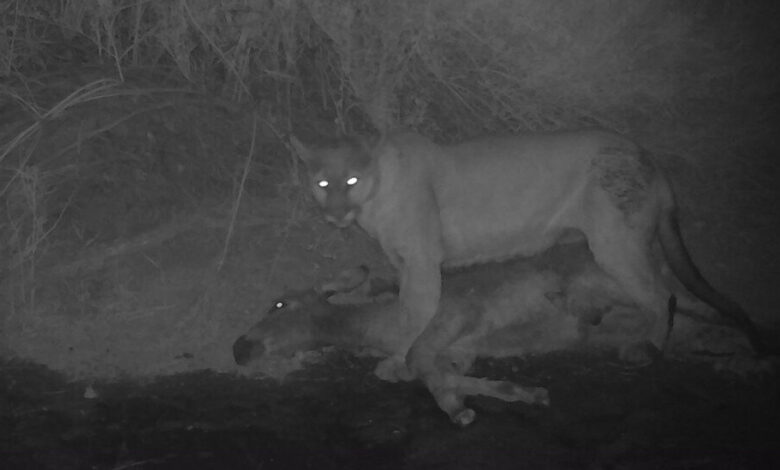Death Valley’s Invasive Donkeys Have Become Cat Food

Early on a June morning in Death Valley National Park, a wild donkey brought her foal to one of the springs scattered throughout the desert. Two sets of eyes watched the foal pick its way through the brush. One set belonged to a mountain lion, the other to a trail camera.
Footage of the subsequent kill was published last month in the Journal of Animal Ecology, in a study that provided direct evidence of mountain lions hunting donkeys in the western deserts of North America. The attacks don’t just result in donkey scraps and full cougars, researchers argue: They suggest that native carnivores act as an important check on nonnative prey. The study also raises questions about how damaging donkeys are in the wild desert landscapes where they are found, although federal wildlife authorities maintain a goal of eliminating them entirely.
Donkeys originated in North Africa but were introduced to the United States through the mining industry in the late 1800s. Federal agencies were not pleased to see the hardy herbivores establish themselves in Death Valley. In the 1930s, wildlife managers began culling donkeys, arguing that herds of burros trampled vegetation, muddied springs and drove away native wildlife like bighorn sheep. But the donkeys have persisted, and decades later, an estimated 4,000 live in Death Valley, despite National Park Service goals of bringing the population to zero.
Erick Lundgren, a biologist at Aarhus University in Denmark took an interest in the donkeys’ effects on the desert’s wetlands. Initially, he focused on donkeys’ habit of digging wells — sometimes up to five feet deep — to reach water beneath dry stream beds. These wells have often been cited as evidence of ecological damage, Dr. Lundgren said. But he and colleagues found in a 2021 study that donkey wells served as nurseries and oases for native plants and animals.
He also found that donkeys congregating near Death Valley campsites could cause damage.
“They pretty much turn these wetlands into just a warren of trails and trampled ground,” Dr. Lundgren said. While some plant species actually benefit from this kind of grazing, he added, the donkeys wipe out other kinds of vegetation that attract birds and store carbon.
But in more remote spring-fed groves, Dr. Lundgren found, donkeys tended not to linger, and their impact on vegetation was much less drastic. At many of the sites, the researchers found mountain lion caches — the stashed carcasses that are hidden away behind boulders or thickets to prevent theft by scavengers and other cats. Many of the Death Valley caches contained donkey remains, suggesting that donkeys in parts of the park were serving an important ecological function: cat food.
Dr. Lundgren and his colleagues surveyed 13 different wetlands with camera traps. Eight of the sites, often the more mountainous spots, showed the remains of donkey kills. In such sites, donkeys seemed to be the predators’ main prey, making up 24 of the 29 hidden carcasses.
At those spots, compared with the springs around campgrounds where fewer lions prowled, there was half as much trampled ground and nearly twice as much canopy cover.
“Our study shows that burros can denude wetlands but only when mountain lions are absent,” Dr. Lundgren said. “This is the case in the most visible springs in Death Valley, which occur at campsites, where mountain lions are fearful to go,” Dr. Lundgren said. He said that the places where wild donkeys do the most damage are “places that are artificially safe because of humans.”
The predators, in other words, were acting as a check on the donkeys, Dr. Lundgren said, moderating their impact on sensitive sites into something ecologically useful — well digging and opening up spring-fed thickets.
Federal wildlife officials disagreed with the researchers’ conclusion.
“Cougar predation is insufficient to control feral donkey populations in the park, which reproduce at a rate of around 20 percent each year, and does not contribute significantly to the management goal of zero nonnative donkeys within the park,” said Abigail Wines, a management assistant with the National Park Service.
Dr. Lundgren replied that the donkey birthrate Ms. Wines cited was based on decades-old estimates. In Death Valley, he said, concrete numbers about donkey populations are hard to come by. He also pointed to research suggesting that mountain lions are potentially important predators for wild horses and burros. A 1999 study found that mountain lions helped control a feral horse population in Nevada, while a 2021 paper found that some cats in the same region relied entirely on wild horses as prey. That could mean mountain lions that target nonnative donkeys in Death Valley may not hunt as many threatened species there, like bighorn sheep, Dr. Lundgren said.
Park staff declined to answer questions about whether having zero burros in Death Valley was attainable, but in the past have acknowledged that wholly eliminating donkeys there is at best an aspirational goal. “We’re always going to have burros,” Alison Ainsworth, then a Death Valley National Park biologist, told Undark Magazine in 2019, noting that herds continue to roam on surrounding federal land.
If the donkeys are now a permanent feature on the landscape, Dr. Lundgren argues, it’s worth seeing them as potential parts of a functional ecosystem, not alien to it.
“A lot of the population numbers you hear and these stories of how horribly invasive these animals are ignoring the fact that predators can hunt them, especially if we leave those predators alone,” he said.




